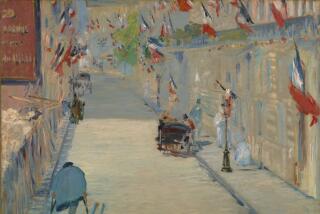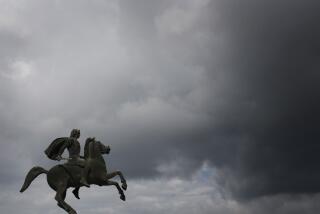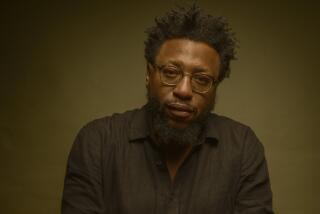Book Review: ‘The Greater Journey: Americans in Paris’
- Share via
The Greater Journey
Americans in Paris
David McCullough
Simon & Schuster: 560 pp., $37.50
For more than 40 years, David McCullough has brought the past to life in books distinguished by vigorous storytelling and vivid characterizations. He garnered praise for his dramatic accounts of epic engineering achievements in such early titles as “The Great Bridge” (the Brooklyn Bridge) and “The Path Between the Seas” (the Panama Canal). Subsequent works showcased McCullough’s gift for full-scale biography, most notably in the Pulitzer Prize winners “Truman” and “John Adams,” appreciative portraits of under-appreciated U.S. presidents.
McCullough again finds a slighted subject in “The Greater Journey,” which chronicles the adventures of Americans in Paris during the century before Gertrude Stein famously declared that Fitzgerald, Hemingway and their expatriate peers were “a lost generation.” Beginning with the arrivals in the late 1820s of James Fenimore Cooper and Samuel F.B. Morse, McCullough reports the varied experiences of abolitionist Charles Sumner, educator Emma Willard, sculptor Augustus Saint-Gaudens, pianist Louis Moreau Gottschalk and many others over the course of seven decades.
The first substantial group of American visitors in the 1830s, few of whom knew much about French culture or even spoke the language, were struck above all by Paris as “a continuing lesson in the enjoyment to be found in such simple, unhurried occupations as a walk in a garden ....{O}ne learned to take time to savor life.” Most of them worked hard; one of the book’s best chapters describes the grueling routine of medical students such as Oliver Wendell Holmes (father of the Supreme Court justice) who came to the great hospitals of Paris to receive training far superior to anything available at home. But they found time to attend the theater and opera, to marvel at the masterpieces in the Louvre. “The conviction of the French that the arts were indispensable …affected Americans more than anything else about Paris,” McCullough concludes.
Later generations of Americans were more cosmopolitan, thanks in part to faster transatlantic crossings by steamships and better communication because of the invention of the electric telegraph — an idea that first came to Samuel Morse in Paris, though he had to go home to the business-minded United States to actually put it into operation in 1844. Richard Morris Hunt, the first American admitted to the École des Beaux-Arts school of architecture, and his brother William, who studied painting in the atelier of Thomas Couture, were among those whose wealthy parents considered a stint in Paris a valuable embellishment to their education. The broad new avenues, upgraded public sanitation and other modern improvements implemented by civic planner Georges-Eugène Haussmann made Paris in the 1850s even more attractive to Americans, though many deplored Louis Napoleon’s coup d’état.
Shortly after the flow of visitors interrupted by the Civil War resumed in the late 1860s, Elihu Washburne found himself faced with the task of getting them safely out when the Franco-Prussian War led to the collapse of the Second Empire and the German siege of Paris in 1870. McCullough rightly praises and extensively quotes from Washburne’s searing diary of the city’s suffering during the siege, the humiliating peace that provoked the radical uprising known as the Paris Commune, and the atrocities perpetrated by both sides as the Third Republic bloodily suppressed the Commune in 1871. However, this is essentially a French story — recounted with intelligence and outrage by a perceptive American observer, granted, but of questionable relevance to the book’s stated subject.
Indeed, as McCullough’s smooth parade of anecdotes moves into the later 19th century, it becomes increasingly clear that his book lacks a unifying theme. Henry James declared Paris more charming than ever in 1875; Mary Cassatt found her artistic home there with the Impressionists later in that decade; John Singer Sargent scandalized the 1884 Paris Salon with Madame X, his sexy portrait of Virginie Amélie Gautreau; their less prominent compatriots flocked to the Exposition Universelle of 1889, which featured a plethora of American inventions in the Palais des Machines. The individual episodes are gracefully strung together, but you begin to wonder what exactly the point is.
McCullough is better at following a construction project or an individual life from start to finish than he is at crafting a coherent narrative structure of his own. His well-written text is so episodic that it ultimately seems unfocused. It should be noted that it’s also wonderfully atmospheric, right down to the closing glimpse of Isadora Duncan and her brother dancing with excitement through the Luxembourg Gardens in 1900. Readers content with an accumulation of such striking moments will find “The Greater Journey” an agreeable, though slightly aimless, expedition.
Smith is a contributing editor for the American Scholar and reviews books for The Times, the Washington Post and the Chicago Tribune.
More to Read
Sign up for our Book Club newsletter
Get the latest news, events and more from the Los Angeles Times Book Club, and help us get L.A. reading and talking.
You may occasionally receive promotional content from the Los Angeles Times.







